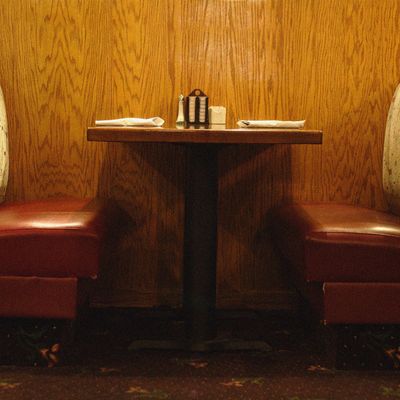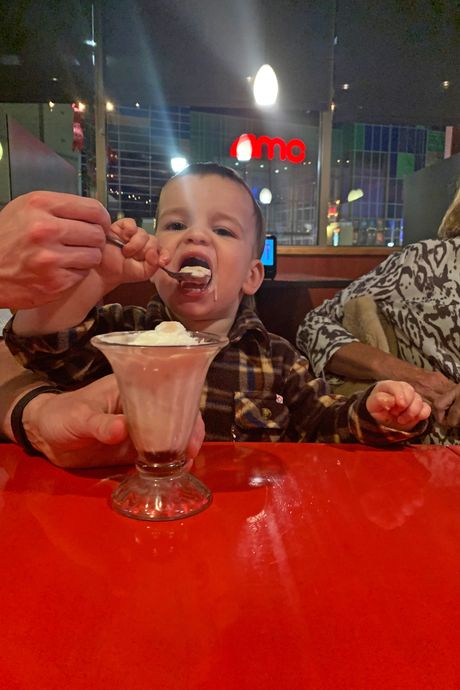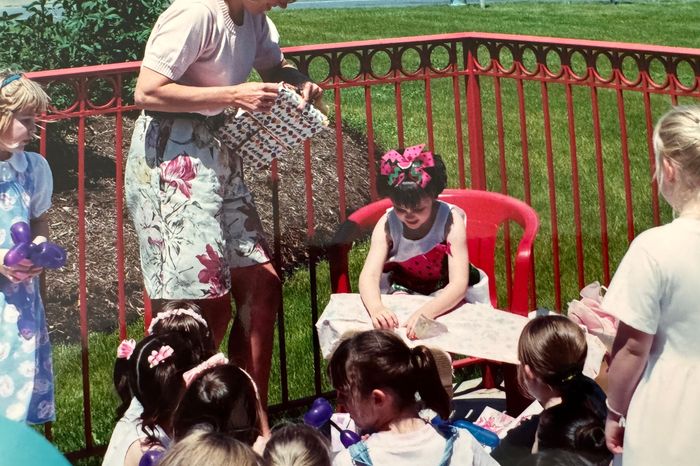
I spent my 19th birthday inside a roomy wooden booth, sitting atop discarded peanut-shell dust, just past a taxidermied armadillo cradling a beer bottle, at, what else, a Texas Roadhouse. I don’t remember what we ordered — some combination of a Cactus Blossom and Rattlesnake Bites, presumably — but what I can recall, in vivid detail, is the moment our server arrived at the end of our meal with a leather saddle. The chain’s birthday routine involves giddyap-ing atop a plywood sawhorse, and my family had apparently told our server I was ready to celebrate. The staff yelled “yeehaw,” all eyes of the restaurant darted our way, and I shrank into the corner of my seat wishing I could evaporate.
Like most millennials raised in a middle-American suburb, chain restaurants were a formative part of my adolescence. My family moved to the Lehigh Valley in 1992 and as that slice of Pennsylvania rebuilt itself in the wake of Bethlehem Steel’s decline, my town benefited from the boom of casual-dining options that seemed to follow pockets of population growth across the country.
In my teens, diners and fast-food spots were typically reserved for post-party-in-the-woods munchies. Chains fell into the “everything else” category, their cushioned booths providing a veil of privacy and affordability that seemed to promise us teenagers could frolic, flirt, and psychoanalyze our drama away from the watchful eyes of parents.
TGI Fridays was my first. At 13, before winter formal, my friends and I enjoyed our inaugural unchaperoned co-ed dinner there. The walls were cluttered with Americana “antiques” (had that full-size crew boat hanging on the wall actually ever seen a body of water? Hard to say!), the servers’ vests were loaded with pins, and the acoustics drowned out my guy friends’ rapid-fire Office Space jokes about flair (we were all finally allowed to watch it earlier that year), allowing our fellow diners to eat their artichoke dips in peace. We may have felt mature, but we still ended the meal with cups of dirt, gummy worms spilling over the edges.
Red Robin taught me the limits of independence at 14. The restaurant, known for its wild and seemingly endless list of burgers, opened in Allentown in the mid-’90s and was filled with carousel-horse décor and anthropomorphic bird paintings. It was just one large parking lot over from the local movie theater and upon starting high school, I was allowed to make the three-minute walk alone. The first time I did so, I went with a friend whose mom forgot to pick us up. Our quiet waiter, otherwise known as “mysterious senior in my Spanish class,” drove us home once his shift ended. I squeaked, “thank you,” when he dropped me off and avoided his gaze in Spanish the rest of the semester.
At 16, Friendly’s provided the backdrop for my first significant romantic relationship: post-movie date sundaes with the guy who’d soon become my boyfriend. The following week, I burned him a CD with the movie’s soundtrack and scribbled the song titles and a drawing of an ice-cream cone. (The movie was, in retrospect, less romantic: Curious George.) About a year later, I sat across from my best friend in a booth at Perkins — a reliable favorite for its big tables and cheap menu — just before our senior year started, devouring chocolate-chip pancakes and crying about that very boy not paying me enough attention.
I celebrated my 18th birthday under Applebee’s Tiffany-esque pendant lights. And while we loved Café “Eatin’ Good in the Neighborhood™,” like our own personal The Max, I was already dreaming of getting away from the Lehigh Valley. My social life felt like a soap opera rife with peak-2000s double standards — think messy breakups and slutshaming — one where chain restaurants were often the setting of drama unfolding and I was the humiliated star. The longer I spent away from home, the more I viewed these places with a complicated resentment.
When I moved to New York after college, I was determined to make it, not to end up back in my childhood room a few months later. I learned quickly — from my new co-workers who’d transplanted before me — that in the Big City, fast food was fine, apparently, but not Olive Garden. So I assimilated, ordering tuna tartare and shoestring fries with my nightcaps. I took to fast-casual kale salads and lunch from food trucks. I began to equate all the things I disliked about where I grew up — the homogeneity, the resistance to change, the handful of bad apples — with these places I had once cherished.


And then I did the thing that usually only happens in Hallmark Christmas movies: I fell for a guy from my hometown. We reconnected on a bus from Allentown to New York after Thanksgiving. He tugged at memories of all the good parts of my growing up: the familial closeness, the supportive communities, the rugged handiness. On our first road trip upstate together, he spotted a sign for Chili’s off I-87. Feeling both hungry and nostalgic, we pulled off at the next exit. I demanded we order a Triple Dipper — a build-your-own sampler platter with your choice of three of Chili’s best appetizers (the correct answer is southwestern egg rolls, boneless wings, and fried pickles), and he demanded we finish our meal with molten-chocolate cake. We reminisced about our high-school experiences; there had been plenty of bad but, with distance, plenty of good, too. Over the next few years, we’d often visit his parents and, as I fell in love with him, I fell back in love with the Lehigh Valley.
Last summer, while spending a weekend with my parents in Pennsylvania, we took our 2- and 4-year-olds to a play space that had opened in a strip mall near my former house. We searched for an easy lunch spot close by and landed on the same TGI Fridays I had gone to as a kid. The walls were bare, minus that single crew boat, the servers weren’t adorned in buttoned suspenders, and a cup of dirt was no longer on the menu — you really can’t go home again. Still, there was that sense of familiarity and predictability. My dad ordered a burger, which he’s consistently done for the past 25 years; my mom led a game of I Spy to keep my kids entertained (effective, though admittedly less fun with minimal flair); and I ordered a Shirley Temple because Friday’s knows how to make ’em. Our kids love to swirl on the burger stools at Red Robin, feel a touch of autonomy when they use a crayon to circle their order on the kid’s menu at Applebee’s, and select their treat of choice from the display case at Perkins. We never feel bad when they leave a meal half-finished since it costs less than $10. There are always a bunch of families, all in various states of disarray, and we never have to worry about outbursts or tantrums ruining a neighbor’s meal. Empathetic diners and space, not nostalgia or sleek settings, are what I look for from these places now. And my kids? They’re making their own set of magical childhood memories.


